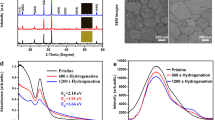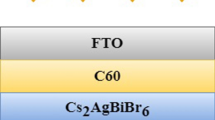Abstract
Cs2AgBiBr6 is a lead-free perovskite that shows great potential to solve the toxicity and instability of organic–inorganic lead perovskite. However, because of the poor interface contact and inferior film quality, the open-circuit voltage and the power conversion efficiency of the solar cells are inhibited. Herein, the Cs2AgBiBr6 film quality is improved by adding formamidinium acetate into the precursor solution. With additive regulation, the grain size increases and the film surface is more smooth. The crystal structure remains unchanged, and the defect density decreases. Correspondingly, the average power conversion efficiency of the target device increases more than 30% than the control device. The best efficiency approaches 2.09%, and the open-circuit voltage is surprisingly high at 1.23 V, the highest value reported for Cs2AgBiBr6 solar cells. Moreover, the device remains more than 90% of its initial efficiency after 40 days of storage under environmental conditions, showing excellent stability. This work is therefore helpful for enhancing the efficiency and stability of inorganic lead-free perovskite solar cells toward future commercialization.




Similar content being viewed by others
Data availability
The authors confirm that the data supporting the findings of this study are available within the article.
References
A. Kojima, K. Teshima, Y. Shirai, T. Miyasaka, Organometal halide perovskites as visible-light sensitizers for photovoltaic cells. J. Am. Chem. Soc. 131, 6050–6051 (2019). https://doi.org/10.1021/ja809598r
National Renewable Energy Laboratory. Best research-cell efficiency chart. https://www.nrel.gov/pv/cell-efficiency.html. Accessed 6 Jan 2022
M. Nayak, A.J. Akthar, A. Guchhait, S.K. Saha, A roadmap towards stable perovskite solar cells: prospective on substitution of organic (A) & inorganic (B) cations. J. Mater. Sci.: Mater. Electron. 32, 18466–18511 (2021). https://doi.org/10.1007/s10854-021-06431-2
Md.A. Karim, K. Matsuishi, T.H. Chowdhury, W.I. Chowdhury, M. Abdel-shakour, A. Islam, Bathocuproine interfacial layer leads to solid improvement of reproducibility and stability of Pb-free CsBi3I10 based perovskite solar cells. J. Mater. Sci.: Mater. Electron. 33, 8114–8126 (2022). https://doi.org/10.1007/s10854-022-07961-z
M. Zhang, Z. Zhang, H. Cao, T. Zhang, H. Yu, J. Du, Y. Shen, X. Zhang, J. Zhu, P. Chen, M. Wang, Recent progress in inorganic tin perovskite solar cells. Mater. Today Energy 23, 100891 (2022). https://doi.org/10.1016/j.mtener.2021.100891
Z. Yi, N.H. Ladi, X. Shai, H. Li, Y. Shen, M. Wang, Will organic–inorganic hybrid halide lead perovskites be eliminated from optoelectronic applications? Nanoscale Adv. 1, 1276–1289 (2019). https://doi.org/10.1039/C8NA00416A
R. Nie, R.R. Sumukam, S.H. Reddy, M. Banavoth, S.I. Seok, Lead-free perovskite solar cells enabled by hetero-valent substitutes. Energy Environ. Sci. 13, 2363–2385 (2022). https://doi.org/10.1039/D0EE01153C
A. Kulkarni, T. Singh, A.K. Jena, P. Pinpithak, M. Ikegami, T. Miyasaka, Vapor annealing controlled crystal growth and photovoltaic performance of bismuth triiodide embedded in mesostructured configurations. ACS Appl. Mater. Interfaces 10, 9547–9554 (2018). https://doi.org/10.1021/acsami.8b00430
A. Kulkarni, T. Singh, M. Ikegami, T. Miyasaka, Photovoltaic enhancement of bismuth halide hybrid perovskite by N-methyl pyrrolidone-assisted morphology conversion. RSC Adv. 7, 9456 (2017). https://doi.org/10.1039/C6RA28190G
T. Singh, A. Kulkarni, M. Ikegami, T. Miyasaka, Effect of electron transporting layer on bismuth-based lead-free perovskite (CH3NH3)3Bi2I9 for photovoltaic applications. ACS Appl. Mater. Interfaces 8, 14542–14547 (2016). https://doi.org/10.1021/acsami.6b02843
E. Greul, M.L. Petrus, A. Binek, P. Docampob, T. Bein, Highly stable, phase pure Cs2AgBiBr6 double perovskite thin films for optoelectronic applications. J. Mater. Chem. A 5, 19972–19981 (2017). https://doi.org/10.1039/C7TA06816F
W. Gao, C. Ran, J. Xi, B. Jiao, W. Zhang, M. Wu, X. Hou, Z. Wu, High-quality Cs2AgBiBr6 double perovskite film for lead-free inverted planar heterojunction solar cells with 2.2% efficiency. ChemPhysChem 19, 1696–1700 (2018). https://doi.org/10.1002/cphc.201800346
C. Wu, Q. Zhang, Y. Liu, W. Luo, X. Guo, Z. Huang, H. Ting, W. Sun, X. Zhong, S. Wei, S. Wang, Z. Chen, L. Xiao, The dawn of lead-free perovskite solar cell: highly stable double perovskite Cs2AgBiBr6 film. Adv. Sci. 5, 1700759 (2018). https://doi.org/10.1002/advs.201700759
B. Wang, N. Li, L. Yang, C.X. Dall’Agnese, A.K. Jena, T. Miyasaka, X. Wang, Organic dye/Cs2AgBiBr6 double perovskite heterojunction solar cells. J. Am. Chem. Soc. 143, 14877–14883 (2021). https://doi.org/10.1021/jacs.1c07200
J. Li, J. Duan, J. Du, X. Yang, Y. Wang, P. Yang, Y. Duan, Q. Tang, Alkali metal ion-regulated lead-free, all-inorganic double perovskites for HTM-free, carbon-based solar cells. ACS Appl. Mater. Interfaces 12, 47408–47415 (2020). https://doi.org/10.1021/acsami.0c11770
M. Wang, P. Zeng, S. Bai, J. Gu, F. Li, Z. Yang, M. Liu, High-quality sequential-vapor-deposited Cs2AgBiBr6 thin films for lead-free perovskite solar cells. Sol. RRL 2, 1800217 (2018). https://doi.org/10.1002/solr.201800217
F. Igbari, R. Wang, Z. Wang, X. Ma, Q. Wang, K. Wang, Y. Zhang, L. Liao, Y. Yang, Composition stoichiometry of Cs2AgBiBr6 films for highly efficient lead-free perovskite solar cells. Nano Lett. 19, 2066–2073 (2019). https://doi.org/10.1021/acs.nanolett.9b00238
Y. Liu, L. Zhang, M. Wang, Y. Zhong, M. Huang, Y. Long, H. Zhu, Bandgap-tunable double-perovskite thin films by solution processing. Mater. Today 28, 25–30 (2019). https://doi.org/10.1016/j.mattod.2019.04.023
N. Pai, J. Lu, M. Wang, A.S.R. Chesman, A. Seeber, P.V. Cherepanov, D.C. Senevirathna, T.R. Gengenbach, N.V. Medhekar, P.C. Andrews, U. Bachbcef, A.N. Simonov, Enhancement of the intrinsic light harvesting capacity of Cs2AgBiBr6 double perovskite via modification with sulphide. J. Mater. Chem. A 8, 2008–2020 (2020). https://doi.org/10.1039/C9TA10422D
X. Yang, Y. Chen, P. Liu, H. Xiang, W. Wang, R. Ran, W. Zhou, Z. Shao, Simultaneous power conversion efficiency and stability enhancement of Cs2AgBiBr6 lead-free inorganic perovskite solar cell through adopting a multifunctional dye interlayer. Adv. Funct. Mater. 30, 2001557 (2020). https://doi.org/10.1002/adfm.202001557
B. Wang, N. Li, L. Yang, C.X. Dall’Agnese, A.K. Jena, S. Sasaki, T. Miyasaka, H. Tamiaki, X. Wang, Chlorophyll derivative-sensitized TiO2 electron transport layer for record efficiency of Cs2AgBiBr6 double perovskite solar cells. J. Am. Chem. Soc. 143, 2207–2211 (2021). https://doi.org/10.1021/jacs.0c12786
J. Li, X. Meng, Z. Wu, Y. Duan, R. Guo, W. Xiao, Y. Zhang, Y. Li, Y. Shen, W. Zhang, G. Shao, Pinning bromide ion with ionic liquid in lead-free Cs2AgBiBr6 double perovskite solar cells. Adv. Funct. Mater. 32, 2112991 (2022). https://doi.org/10.1002/adfm.202112991
F. Zhang, K. Zhu, Additive engineering for efficient and stable perovskite solar cells. Adv. Energy Mater. 10, 1902579 (2020). https://doi.org/10.1002/aenm.201902579
X. Yang, A. Xie, H. Xiang, W. Wang, R. Ran, W. Zhou, Z. Shao, First investigation of additive engineering for highly efficient Cs2AgBiBr6-based lead-free inorganic perovskite solar cells. Appl. Phys. Rev. 8, 041402 (2021). https://doi.org/10.1063/5.0059542
H. Wu, Y. Wang, A. Liu, J. Wang, B.J. Kim, Y. Liu, Y. Fang, X. Zhang, G. Boschloo, E.M.J. Johansson, Methylammonium bromide assisted crystallization for enhanced lead-free double perovskite photovoltaic performance. Adv. Funct. Mater. 32, 2109402 (2022). https://doi.org/10.1002/adfm.202109402
R. Fu, Y. Zhao, W. Zhou, Q. Li, Y. Zhao, Q. Zhao, Ultrahigh open-circuit voltage for high performance mixed-cation perovskite solar cells using acetate anions. J. Mater. Chem. A 6, 14387–14391 (2018). https://doi.org/10.1039/C8TA04453H
R. Xu, H. Dong, P. Li, X. Cao, H. Li, J. Li, Z. Wu, Formamidine acetate induces regulation of crystallization and stabilization in Sn-based perovskite solar cells. ACS Appl. Mater. Interfaces 13, 33218–33225 (2021). https://doi.org/10.1021/acsami.1c05097
J. Zhang, Z. Wang, A. Mishra, M. Yu, M. Shasti, W. Tress, D.J. Kubicki, C.E. Avalos, H. Lu, Y. Liu, B.I. Carlsen, A. Agarwalla, Z. Wang, W. Xiang, L. Emsley, Z. Zhang, M. Grätzel, W. Guo, Intermediate phase enhances inorganic perovskite and metal oxide interface for efficient photovoltaics. Joule 4, 222–234 (2020). https://doi.org/10.1016/j.joule.2019.11.007
Z. Chen, Q. Wang, Y. Xu, R. Zhou, L. Zhang, Y. Huang, L. Hu, M. Lyu, J. Zhu, Regulating the film growth and reducing the defects for efficient CsPbIBr2 solar cells. ACS Appl. Mater. Interfaces 13, 24654–24661 (2021). https://doi.org/10.1021/acsami.1c02377
X. Zhang, H. Xiong, J. Qi, C. Hou, Y. Li, Q. Zhang, H. Wang, Antisolvent-derived intermediate phases for low-temperature flexible perovskite solar cells. ACS Appl. Energy Mater. 1, 6477–6486 (2018). https://doi.org/10.1021/acsaem.8b01413
W. Tress, M.T. Sirtl, Cs2AgBiBr6 double perovskites as lead-free alternatives for perovskite solar cells? Sol. RRL 6, 2100770 (2022). https://doi.org/10.1002/solr.202100770
Y. Bekenstein, J.C. Dahl, J. Huang, W.T. Osowiecki, J.K. Swabeck, E.M. Chan, P. Yang, A.P. Alivisatos, The making and breaking of lead-free double perovskite nanocrystals of cesium silver–bismuth halide compositions. Nano Lett. 18, 3502–3508 (2018). https://doi.org/10.1021/acs.nanolett.8b00560
X.-G. Zhao, J.-H. Yang, Y. Fu, D. Yang, Q. Xu, L. Yu, S.-H. Wei, L. Zhang, Design of lead-free inorganic halide perovskites for solar cells via cation-transmutation. J. Am. Chem. Soc. 139, 2630–2638 (2017). https://doi.org/10.1021/jacs.6b09645
J. Li, F. Yan, P. Yang, Y. Duan, J. Duan, Q. Tang, Suppressing interfacial shunt loss via functional polymer for performance improvement of lead-free Cs2AgBiBr6 double perovskite solar cells. Sol. RRL 6, 2100791 (2022). https://doi.org/10.1002/solr.202100791
V. Sarritzu, N. Sestu, D. Marongiu, X. Chang, S. Masi, A. Rizzo, S. Colella, F. Quochi, M. Saba, A. Mura, G. Bongiovanni, Optical determination of Shockley–Read–Hall and interface recombination currents in hybrid perovskites. Sci. Rep. 7, 44629 (2017). https://doi.org/10.1038/srep44629
W. Pan, H. Wu, J. Luo, Z. Deng, C. Ge, C. Chen, X. Jiang, W. Yin, G. Niu, L. Zhu, L. Yin, Y. Zhou, Q. Xie, X. Ke, M. Sui, J. Tang, Cs2AgBiBr6 single-crystal X-ray detectors with a low detection limit. Nat. Photon. 11, 726–732 (2017). https://doi.org/10.1038/s41566-017-0012-4
Acknowledgements
The acknowledgements come at the end of an article after the conclusions and before the notes and references. This work was supported by the National Key Research and Development Program of China (2019YFE0101300) and the Hefei Municipal Natural Science Foundation (2021040).
Funding
This work was supported by National Key Research and Development Program of China (Grant No. 2019YFE0101300), Hefei Municipal Natural Science Foundation (Grant No. 2021040).
Author information
Authors and Affiliations
Contributions
Research idea: JZ, ML; Methodology and writing-original draft preparation: AY; Data curation: AY, LZ; Validation: LZ, QW; Conceptualization and investigation: YX; Formal analysis: ML, HL; Resources: QW, HL; Writing-review and editing: JZ; Supervision: ML, JZ.
Corresponding author
Ethics declarations
Conflict of interest
The authors declare that they have no known competing financial interests or personal relationships that could have appeared to influence the work reported in this paper.
Additional information
Publisher's Note
Springer Nature remains neutral with regard to jurisdictional claims in published maps and institutional affiliations.
Supplementary Information
Below is the link to the electronic supplementary material.
10854_2022_8724_MOESM1_ESM.pdf
Supplementary file1 (PDF 587 KB)—PL and TRPL spectra; J–V curves of forward scan and reverse scan; Statistic photovoltaic parameters; Fitted lifetime parameters; Photovoltaic parameters and hyssteresis index.
Rights and permissions
About this article
Cite this article
Yang, A., Zhang, L., Xu, Y. et al. VOC over 1.2 V for Cs2AgBiBr6 solar cells based on formamidinium acetate additive. J Mater Sci: Mater Electron 33, 18758–18767 (2022). https://doi.org/10.1007/s10854-022-08724-6
Received:
Accepted:
Published:
Issue Date:
DOI: https://doi.org/10.1007/s10854-022-08724-6




